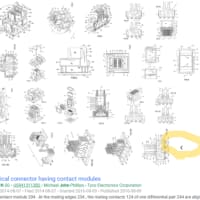WO2013171728(特表2015-534423)
"1. A method of reducing electromagnetic drag in a variable speed electric motor unit the operating speed of which is capable of being varied, the variable speed electric motor comprising: a laminated stator(積層固定子)having wire slots disposed around the inner periphery spaced into N equally spaced sectors separated by a pole iron support structure, the slots containing induction windings;
a series of wound lateral pole irons(巻線横方向磁極鉄心)arranged around the inner periphery of the stator, the first ends of the lateral pole irons extending into the slots spaced in the N sectors around the inner periphery of the stator;
the method comprising:
sequentially energizing(励磁)the windings of the lateral pole irons in the N sectors, each of the N sectors being energized so as to provide a moving magnetic field to generate a torque applied to rotate the rotor, pole sections of the free-wheeling permanent magnet inserts rotating into alignment with ones of the second ends of the lateral pole irons to increase a flux linkage(鎖交磁束)with the lateral pole irons and the corresponding one of the N sectors, the first ends of the lateral pole irons inducing a current flow in the stator induction windings of the corresponding one of the N sectors"
WO2007111970(特表2009-531015)
"12. The aircraft starting and generating system according to claim 11, wherein the [alpha] and [beta] artificial flux linkages(模擬磁束鎖交数)are defined as [lambda][alpha]' and [lambda][beta]% and wherein the rotating angle [theta] of the starter is determined by the following equation: [theta] = tan ([lambda][beta] / [lambda][alpha])."
US8772976(特表2014-518057)
"For instance, application circuit module 106 generates an electrical current 120 that flows through transmitting coil 102. This results in the generation of a magnetic field. Through this magnetic field, transmitting coil 102 creates a flux linkage with(磁束鎖交を生成)receiving coil 104. As a result, an inductive coupling is achieved. Consequently, a current 126 is induced in receiving coil 104. In turn, current 126 is received by application circuit module 108."
WO2015073651(特表2016-537949)
"[0069] The flux linkage rate(磁束鎖交率)(which can be written as used by the torque ripple estimator may be measured in any suitable manner such as with the sensor or pick up coil 1100 shown in Figs. 11A and 11B, which may be located on or adjacent the respective coil. In other aspects the sensor 1100 may be located(配置)at any suitable position for measuring the flux linkage. The sensor 1100 may be an independent coil positioned such that as the phase coil 104 is energized(励磁)(e.g. as a result of commutation) the magnetic flux linkage(磁束鎖交)generated within the stator pole 103P is induced in the sensor 1100. The rate of change of the flux linkage with the resistance, current and terminal voltage across the sensor 1100 coil is defined by equation [4] above. By connecting the sensor 1100 to a high impedance channel (such as an analog to digital converter or any other suitable high impedance channel) the associated current can be neglected and what remains is the terminal voltage (see equation [11] below) that is a substantially direct measurement of the rate of change of flux linkage across the stator pole."
WO2013062427(特表2015-504238)
"Continuing with the leakage flux differences Fig 15, and Figs 12 and 13, show flux plots for DD and concrete pads respectively. In all the plots the flux lines can be divided into two categories: Potentially-linkage flux completes its path above the roadway surface and some of it can potentially link to a pick-up(ピックアップに鎖交する)if a pick-up is present, while leakage flux completes its path below the roadway surface and can never link to a pick-up. There are other leakage flux paths(漏れ磁束経路)that exist completely within the pad but these are not at issue here."
WO2007139937(特表2009-538594)
"Adjacent faces of the rotor and stator are separated by a small airgap traversed by magnetic flux(*無冠詞)linking the rotor and stator(ロータとステータを鎖交する磁束). It will be understood by those skilled in the art that a rotating machine may comprise plural, mechanically connected rotors and/or plural stators. Virtually all rotating machines are conventionally classifiable as being either radial or axial airgap types. A radial airgap type is one in which the rotor and stator are separated radially and the traversing magnetic flux(横断磁束)is directed predominantly perpendicular to the axis of rotation of the rotor. In an axial airgap device, the rotor and stator are axially separated and the flux traversal is predominantly parallel to the rotational axis."



























※コメント投稿者のブログIDはブログ作成者のみに通知されます